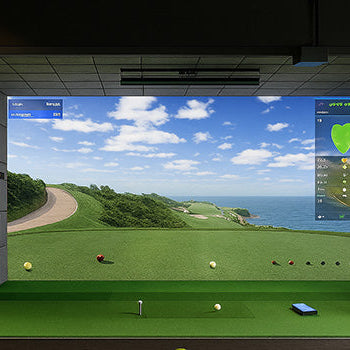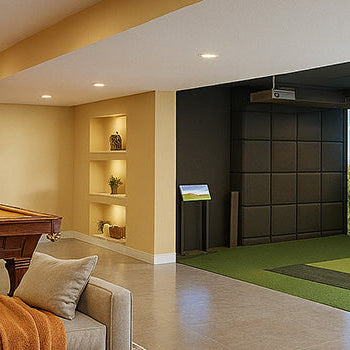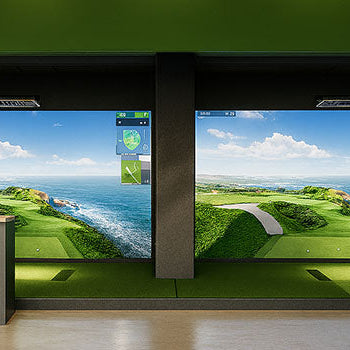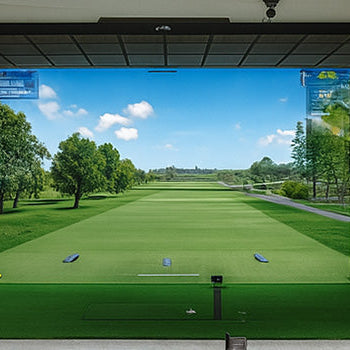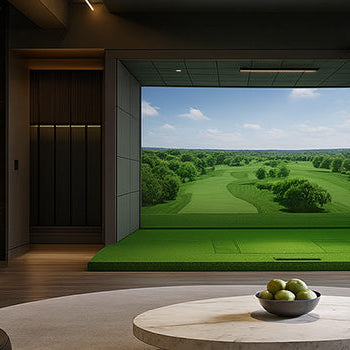Ever smacked your ceiling light mid-backswing? Yeah, you’re not the only one. If you're setting up a home Golf Simulator, the sweet spot is 12 feet long, 10 feet wide, and 9 feet high. That gives you enough space to swing comfortably, track the ball, and keep your home in one piece. But that’s just the baseline. Your height, equipment, and goals will all shape the perfect setup.
Stick around, we’re diving into real dimensions, smart layouts, and how to make even small spaces work.

The Three Critical Dimensions: Height, Width, and Depth
Why There Isn't One "Perfect" Size for Everyone
Let’s clear this up, there’s no universal best size for a golf simulator. Why? Because no two golfers swing the same way.
One player might take tight, compact swings with wedges. Another might be 6’3” and launching drivers like they’re auditioning for the tour.
The space you need depends on your swing, your build, and the clubs you want to use. It's about making the room work for you. If you're not sure what type of simulator fits your style.
The "Swing Test": Your First and Most Important Measurement
Before you grab a tape measure, try this: stand in your chosen space and take a full, confident swing.
Driver, not wedge. Imagine you're on the first tee.
If you feel cramped, your simulator won’t be fun, it’ll be frustrating. This “swing test” tells you more than any ruler ever could.
Understanding the Difference Between Minimum, Comfortable, and Ideal Sizes
Here’s how to think about it:
-
Minimum means it technically works, but expect compromises.
-
Comfortable gives you a natural swing and smooth setup.
-
Ideal feels like a dedicated golf bay at your local club.
Going too small can make you regret the setup, so aim for comfortable at the very least, and stretch to ideal if you can.
Ceiling Height: The Most Important Measurement
The Ideal Height: 3m (10ft) for Complete Swing Freedom
If you want stress-free swings with every club in the bag, 3 metres (10 feet) is the gold standard.
You won’t have to worry about hitting lights, scraping ceilings, or adjusting your swing.
It’s especially important if you're tall or tend to swing with a high arc. This height gives your simulator a “real range” feel.
The Comfortable Height: 2.7m (9ft) for Most Golfers
This is the height most people work with, and for good reason. It’s standard in many homes and garages.
You can swing almost every club confidently, and it feels like a proper setup without needing major room renovations.
For the average golfer, 2.7m does the job.
The Absolute Minimum: 2.5m (8.5ft) – With Caveats
Yes, you can squeeze a simulator into 2.5m, but there’s a catch.
You might have to avoid the driver indoors, especially if you’re over six feet tall. Shorter clubs work fine, and careful placement helps.
Use lower tees, compact mats, and avoid any ceiling-mounted extras if you're working with tight headroom.
How Your Personal Height and Swing Plane Affects This
Here’s where it gets personal.
If you’re on the taller side or have a more vertical swing plane, you’ll need every bit of headroom.
On the flip side, shorter golfers or those who swing flatter can often make do with less.
Measure your height, record your swing, and plan accordingly. Your swing style might surprise you.

Room Width: Accommodating Your Swing and Friends
The Ideal Width: 4.5m (15ft) to Centre the Tee for All Players
If you want to centre the hitting mat and allow both left and right-handed players to swing freely, you’ll need around 4.5m (15ft).
This setup works great for families, friend groups, or dual-player sessions.
You’ll also have space for storage, screens, and a clean, symmetrical layout.
The Comfortable Width: 3.6m (12ft) for a Single Right or Left-Handed Golfer
Playing solo? This width works nicely.
At 3.6m, you can still swing fully and get a realistic experience. You may need to slightly offset the hitting area depending on your dominant hand, but it’s barely noticeable.
Great for home offices or hobby rooms doubling as your practice space.
The Absolute Minimum: 3m (10ft) for a Dedicated, Offset Hitting Area
If you’re working with just 3m, plan to offset the mat to one side, right or left-handed only.
It’s not ideal, but it’s absolutely usable. You’ll need to get clever with placement, and you won’t have much wiggle room on either side.
Still, it beats not practicing at all.
Room Depth: Ensuring Safety and Accurate Tracking
The Ideal Depth: 5.5m (18ft) for Safety and Equipment Space
This is where most people underestimate their needs.
At 5.5m, you’ve got room for a full swing, ball flight, and equipment placement, without feeling cramped. Plus, it’s safer. You won’t be standing inches from a wall or worried about bouncing balls.
If you have the depth, use it.
The Comfortable Depth: 4.5m – 5m (15–16.5ft)
This range suits most indoor spaces, garages, basements, spare rooms.
It’s enough for a natural swing and proper equipment layout, especially if you're not using radar-based tracking that requires extra space behind you.
You'll feel comfortable here without sacrificing performance.
Key Distances: Space from Screen to Golfer and Golfer to Back Wall
Here’s what you need for optimal spacing:
These distances help protect your gear and allow accurate ball tracking. Don’t skimp here, it’s tempting, but you’ll regret it if shots start veering wild.
How Your Launch Monitor Choice Affects Depth Requirements (Radar vs. Camera)
Radar systems need more depth, as they track the ball over distance from behind the player.
If space is tight, camera-based systems are more forgiving, sitting beside or in front of the hitting area.
Your choice of tracking tech will either free up space, or demand more of it. Plan around it from the start.
Summary: Recommended Room Sizes
The "No Compromises" Room: 3m H x 4.5m W x 5.5m D
This is the dream setup. Enough room for full swings, left- and right-handed play, and the flexibility to upgrade your gear anytime.
If you’ve got it, use it. You won’t regret the extra comfort and safety.
The "Comfortable & Popular" Room: 2.7m H x 3.6m W x 5m D
This is the most common setup among homeowners.
It balances performance with practical room sizes, fitting comfortably into garages and converted rooms without breaking the bank, or knocking out a wall.
The "Compact" Room: 2.5m H x 3m W x 4.5m D
Tight but mighty.
This setup proves even small spaces can deliver big results. You’ll need to be strategic with layout and tech, but it absolutely works for solo practice.

Frequently Asked Questions About Simulator Space
Can I put a simulator in a standard UK garage?
In most cases, yes.
A standard UK garage is often around 2.4–2.6m high, so it’s close to the limit. You might need to ditch the driver and opt for shorter clubs.
Still, with smart layout choices, you can definitely make it work.
Do I need extra space for both right and left-handed players?
Yes, if you want a seamless shared setup. To centre the tee and give both players equal room, you’ll need about 4.5m (15ft) in width.
Otherwise, one player will always be adjusting mats or monitors. Less fun, more fiddling.
What is more important, width or depth?
They both matter, but if you have to choose, depth usually comes first.
Without enough depth, you can’t track the ball accurately or swing freely. That said, lefties in a narrow room will find width quickly becomes a dealbreaker too.
Balance is the goal, but depth is your foundation.
